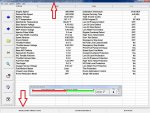Last year I noticed the port engine started to run a bit higher than it did previously (165-170) and took noticeably longer to 'recover' when going from cruising speed down to wake speed.
Ted. I went back to the beginning to look for where you had swapped the temp gages to verify them and started thinking about a problem I had with a Ford Taurus a few years back.
My Mo-in-law complained that her heater wasn't making warm air so I started looking for obstructions in the cooling system (particularly in the heater core)
Now aside from maybe just trying to make it worse

(I actually have a pretty good relationship with her so I shelved that idea!!


)........ The heater core was actually nearly plugged but that wasn't the whole problem!
I DID find that due to what I discovered later was electrolysis, the stamped steel water pump impeller was nearly corroded away (the impeller looked like a wimpy saw-blade!!) and simply could NOT move an adequate amount of water/AF mix through the heater core. She didn't mention what the temp gage was doing, but truth be known, she never looked at it anyway!!!
I have never heard of electrolysis happening in the cooling system of a closed cooled marine engine, but now that I think of it, I seem to remember my San Juan Engr FULL system having a "zinc" in the closed cooling side. Is it possible that this thing has disappeared and now your impeller has started to disappear as well?
Your description above that it now takes longer to "recover" at idle might indicate that the pump doesn't move enough coolant to "recover" as quickly as the STB engine, might tell me that the port recirculating pump isn't moving as much coolant as the STB engine at idle.
Also, heat transfer
RATE at idle after a hard run would NOT seem to be related to fuel mixture, timing or other NON-cooling system issues. Engines at idle regardless of fuel mixture, timing etc don't generate a huge amount of heat.
So the cool down
rate would seem to be directly proportional to the (recirc-pump) coolant flow rate
assuming raw water flow rates and heat exchanger efficiencies are approx equal.
In that old Taurus, the coolant temp with the "saw-blade" pump didn't over heat driving down the road because it actually moved *some* coolant though the engine and radiator BUT, It DID run considerably hotter than "normal" .........AND the temp didn't drop much at all at idle. (after replacing the pump, everything went back to normal)
Just trying to excercise my 40 years back thermodynamics training and suggesting another "tree to bark-up" while looking for the right one!! Don't sell that thing yet!!
Cheers,
Rick






















